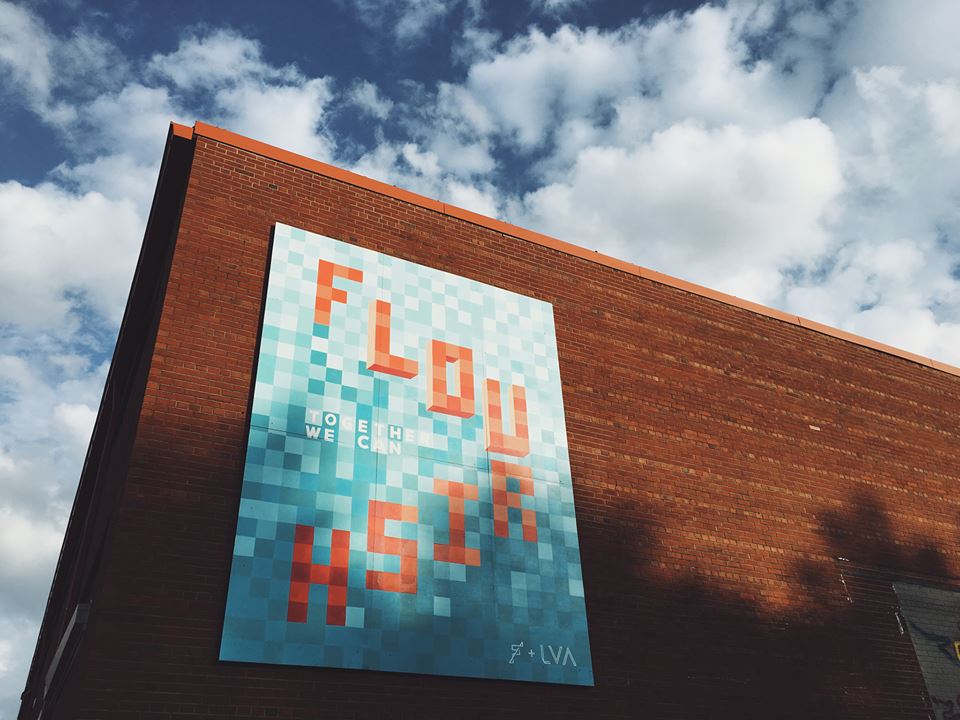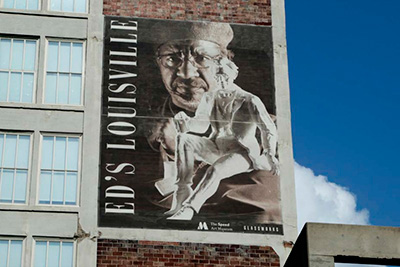“It's an exciting time for Portland! It is where the artists are now.” – Lynn Dunbar
Casey McKinney at work on his mural.
Artists place a high value on space, particularly the space in which they work. It can define them and their work more than even they themselves sometimes realize. When Louisville Visual Art (LVA) moved into its new home in the Portland neighborhood, the 32,000 square foot warehouse was a raw shell except for a cozy 1000 sq. ft. office space. That office remains the only part of the building with heat and air conditioning, and the seasonal extremes in temperature make occupying the vast open space a challenge. A complete renovation of the building that will include studio space for artists is being planned, but for now, LVA staff didn’t anticipate very much use of the facility when they moved in at the beginning of September 2015.
But a tour of the building for a small group of local artists a month later demonstrated that some artists were ready to move in immediately, with or without amenities. The “rawer” the better seemed to be the attitude, “It doesn’t intrude,“ explains sculptor, curator, and LVA board member Andrew Cozzens, “and it provides the space needed to build and experiment without limitations.” With elbowroom to spare, the first three tenants, painters Joshua Jenkins and Clare Hirn, and ceramicist Amy Chase, moved in before the end of 2015.
An installation by Andrew Cozzens (2016)
This hardy trio worked through the cold winter months with space heaters. For Jenkins, who has previously worked in smaller spaces that offered isolation, the difference has impacted the work itself. “Raw space to me is like a blank canvas,” he says. “It has unlimited possibilities and room to breath. I have found that just from painting in a raw/large space such as LVA’s, that my work has naturally evolved and that my compositions have grown to have more white space in them.” Since the first humid, dog days of summer the number of tenants has more than doubled, with seven others moving into the 2nd floor space: besides Cozzens, they are painter Ashley Brossart, installation artist Vinhay Keo, muralist Alyx Mclain, painter Casey McKinney, sculptor and installation artist Kyle Sherrard, and painter Lynn Dunbar. Other artists that have used the building on a temporary basis for murals and other projects on a scale that their normal workspace could not contain have included Shohei Katayama, Carrie Neumayer, Annette Cable, Noah Church, McKenna Graham, Ewa Perz, and Mary Dennis Kannepell.
The increased number of working artists is welcomed by Clare Hirn, who was the first to move in: “After working in a fairly isolated situation this is a nice change to be in a space with other artists. There are challenges of giving up the complete privacy of one's own space, but the potential for collaboration in spirit, if not in actual work, is a huge payoff. It is inspiring to be around other artists of such variety and as a slightly older artist (at 52!) it is a bonus to be around younger people as well.”
"Share the Summer" (Painted at the at the Botanica Paint Out) by Clare Hirn, mixed media, $350 | BUY NOW
Not surprisingly, some of the occupants have taken a hand in improving the space themselves, with Cozzens and Sherrard building and installing temporary partitions, and Dunbar replacing broken glass panes, building a shared space that is still open and accessible. Cozzens admits, “I always prefer to work communally- it brings good energy.”
Artist Joshua Jenkins working in studio. Photo by Sarah Katherine Davis For LVA (2016)
That the building is located in the Portland neighborhood also seems to hold an appeal, as Jenkins explains: “I have always been attracted to urban environments and inner cities. There's just inspiration to me in every direction that I look, along with the ghost of so much history. When I first heard of artists moving into the Portland area for studio spaces I was extremely excited and jumped on board as soon as I could.” The history of the area, which was once one of the most important freight stops on the Ohio River and the economic center of Louisville until the early 1800’s, is rich but largely ignored or taken for granted by the city as a whole, if not necessarily by the artists who are working there. “There is a fresh vibe in Portland,” observes Cozzens“…a lot of stored energy.”
Indeed, with a warren of more developed studio spaces in the connected building, Tim Faulkner Gallery across the street, and the forthcoming Hite Art Institute’s MFA studios scheduled to open 2 blocks away, things seem to be happening – positive and creative things that feed into the larger Portland revitalization plan spearheaded by Gill Holland. Part of the realization of such plans is certainly deep-pocket investors, but equally important are the series of choices made by individuals to live and work in such neighborhoods. These artists have made that choice.
"Untitled" by Ashley Brossart, 5x5ft, aerosal, acrylic, ink, paper photo (2016), NFS (commissioned)
"Withstanding Fiction" by Amy Chase, 5x9x5in, ceramic, flocking (2016), $410 | BUY NOW
"Boy Blue" by Joshua Jenkins, 40x30x1in, acrylic and mixed media on canvas (2016)
"Belle in the Lead" by Lynn Dunbar, 24x36in, oil on canvas
"Watchful Eye" by Casey McKinney, 45x56in, acrylic and mixed media (2016), $900 | BUY NOW
This Feature article was written by Keith Waits.
In addition to his work at the LVA, Keith is also the Managing Editor of a website, www.Arts-Louisville.com, which covers local visual arts, theatre, and music in Louisville.
Are you interested in being on Artebella? Click here to learn more.
Written by Keith Waits. Entire contents copyright © 2016 Louisville Visual Art. All rights reserved.
Please contact josh@louisvillevisualart.org for further information on advertising through Artebella.



























